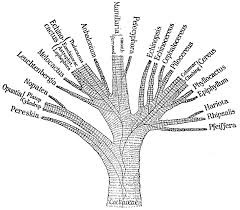In Parts 1 and 2 we reviewed evolutionist Alexander Mebane’s commentary on the “disconfirmations” of Darwinian evolution. We continue here beginning with #5 (a).
5a. First Taxonomic Disconfirmation: Cladistic Iconoclasm
In perusing the internet for definitions of “cladism” and “cladogenesis,” some of the definitions one will find are as follows:
- the theory that cladistic methods based on shared characteristics of organisms yield their true evolutionary relationships and provide the basis for a natural biological classification;
- Cladistics is an approach to biological classificationin which items are grouped together based on whether or not they have one or more shared unique characteristics that come from the group’s last common ancestor and are not present in more distant ancestors. …
- noun, Biology 1.
the cladistic method of classification. - a method of classifying living organisms, often using computer techniques, based on the relationships between phylogenetic branching patterns from a common ancestor
- Cladogenesis definition, evolutionary change by the branching off of new speciesfrom common ancestral type
- Cladogenesis is an evolutionary splitting eventin a species in which each branch and its smaller branches forms a “Clade”, an evolutionary mechanism and a process of adaptive evolution that leads to the development of a greater variety of sister species.
This should be sufficient to inform the reader of the nature of this section of Mebane’s thesis. It would appear, then, that cladism is more or less the equivalent of “taxonomy” or “systematics.” This is a highly telling and significant section of Mebane’s book.
“Well, what is meant by taxonomy?…It is the classification of organisms in a biologically-realistic fashion, which historically goes back to Linnaeus (1707-1778)….Linnaeus concerned himself only with displaying the interrelationships between plants and animals now living but when fossil remains of many others now extinct began to be recognized, a need was felt to introduce the time dimension…Although Linnaeus had taken it for granted that [note well—T. S.] species are by nature ‘fixed’, evolutionists soon arose…who would deride that idea as a naïve old superstition…they declared that all present species are in fact only… ‘twigs’ of a single vast genealogical tree…the task of taxonomists was now to assign to every living or dead life form…its proper position on the great genealogical Tree of Life.” –pg. 29

Carolus Linnaeus by Hendrik Hollander 1853
Note well that Linnaeus, the founder of zoological taxonomy, believed in the biblical view of the “fixed” nature of living organisms. This deserves to be emphasized. This whole scenario is an example of what I mentioned at the beginning of this article about what is essentially a Judeo-Christian pursuit being highjacked by the priests of Secular Humanism. And it was never an honest endeavor to begin with–not on the part of Darwin nor on the part of many other evolutionists who were all fully aware that the existing evidence from paleontology and animal husbandry were contrary to their speculations. The “theory” of evolution was never about the actual evidence, it was always about the anticipated evidence that evolutionists hoped to find some time in the future. It has always been a theory in spite of the evidence.
Now to the focus of this section:
“(S)ince 1965 a vigorous ‘reform’ movement called ‘cladism’ has arisen, which argues that it is a logical mistake for a taxonomist to concern himself with ancestor-descendant relationships…and abstain altogether from genealogical speculation…But this inevitably led to the far more radical claim…that it is…impossible to discover genuine ancestor-descendant relations, for the very fundamental reason that the whole classic ‘Evolutionary Tree’ picture is an unreal and merely imaginary schema, none of which can be verified in the real world!…leading taxonomists, experts in their field…have become so totally iconoclastic as to expressly repudiate not only Darwin’s, but all theories of ‘natural evolution’.”—pg. 29
A couple pages later, Mebane observes:
“The sudden casting off of this old scheme looks, then, like a belated revolt of empirical facts against the dead hand of the Stalinistically-enforced orthodoxy, exactly as has happened in paleontology, where the old pretence that the evidence ‘supported Darwin’ was violently overthrown in Europe by Schindewolf in 1950, and in America by Gould and Eldredge in 1972.”—pg. 31
The reader should understand that this revolution has been done by the hand of the evolutionists themselves feeling the juggernaut-force of overwhelming empirical facts. Pretense can only be carried so far. There comes a point where taking pretense even further manifests oneself as a bald-faced liar, and this is something the taxonomists have been unwilling to do. This does not mean that the evolutionists are ready and willing to declare that all the available evidence points to the creation of life by the hand of an intelligent, omnipotent God (although the evidence certainly does precisely that). This is why you do not see these facts brought out, front-and-center, for public display. Don’t expect to see the next episode of “Nature” or “National Geographic” or “Nova” or “Discovery” trumpeting the fact that all existing theories of evolution are now known definitively to be false. This would require our academic and scientific establishments to muster up more honesty and integrity than they possess. This situation is, in essence, a test of the limits of their honesty.
Mebane says:
“The complete absence of verification of all of the necessary ancestors must inevitably lead to skepticism about the real historical existence of a ‘tree’ whose basic skeleton consists of deduced, but in fact unknown, taxonomic groupings.”—pg. 30
I have a question: what other field of “science” would be given a free pass on producing empirical evidence in its support? Yet, the paleontological and biological sciences have been given precisely that on the subject of evolution. I say bluntly it is high time (actually LONG PAST high time) to put up or shut up. 155 years of vain, baseless speculations which have proven false is ENOUGH! Way more than enough! Yet, since the underlying religious tenets of the prophets of the religion of Secular Humanism are at stake here, the lies and the falsehoods are given free reign to go on, year after year, decade after decade, without being called to account.
Mebane finishes up this section thusly:
“Why has this revolution remained a ‘quiet’ one, which has not been noised about and brought to public attention? My conjecture is that the iconoclasts have naturally been asked what ‘truer’ picture of biological history they would now put in the place of the rejected genealogical one, and have found that an exceeding awkward question to answer…but one can hardly blame the taxonomists if, rather than publicly affirm such a conclusion, they have preferred to say nothing at all.”—pg. 31
Translation: “The truer picture of biological history is that the biblical one of distinct species created by an omnipotent God is the only coherent picture conceivable, but we simply can’t concede this fact. Silence is better!” The taxonomists (or “cladists” or “systematicists”, or whatever term your prefer) understand quite well that a single word from a prominent evolutionist can forebode the end of their academic funding or career. Silence is literally gold! Silence is the price for the continuation of a taxpayer-funded paycheck and retirement pension.
5b. Second Taxonomic Disconfirmation: Observed Non-Genealogical Relationships

“There is also a continual reassignment of more closely studied organisms to new locations on the ‘phylogenetic tree’, because they are now realized to possess features incompatible with the earlier placement. And in this shifting about, it not uncommonly happens that insoluble dilemmas arise…What we are seeing…is abundant proof that cladists are right in calling genealogical trees imaginary schematizations, which cannot be fitted to the real facts of ‘Nature’…The fact is that taxonomists have been dutifully attempting to carry out an inherently impossible task.”—pgs. 32-33, emph. supp
We have all seen illustrations of these “phylogenetic trees” endlessly paraded before us, first when we were children in school textbooks, in popular books, on television programs, in trade publications, on internet sites, and in natural history museums as if these representations are the assured and final conclusions of paleontology and biology. Yet how many times have the purveyors of these representations alerted their readers, watchers and visitors that the taxonomists themselves do not believe in them? And that the specifics of these imaginary trees are continually shifted around? And that the vast gulf between one notch on the tree and the next notch is so vast that no academician hopes to ever fill the gaps? Until these facts are prominently highlighted to the general public, the charge of deliberate misrepresentation of the data must be levelled against all who publish and disseminate these phylogenetic representations.
- Disconfirmation by Prohibitive Improbability of “Accidentally” Producing Observed Results
Mebane cites the mathematical computations of French physicist Lecomte Du Nouy regarding the chance possibilities of random chemical processes producing even the simplest of proteins. Suffice to say the possibility is so staggeringly and mind-boggling small that the odds against such chance occurrence are astronomically high and then some.
“This number is so invisibly tiny…that the natural formation…is thus demonstrated to be strictly impossible. This amounts to a proof that, even when making the most favorable assumptions conceivable, one is simply forbidden to take seriously the proposition that ‘Life on Earth must have arisen spontaneously, in some natural and unintentional way’.”—pg. 36
The reader should linger long over this consideration. Though arguments from mathematics are abstract to most people and lack the tangibility of rocks and fossils, the real world of atoms and elements and chemicals is completely subject to these mathematical limitations. And these mathematical limitations tell us that it is simply impossible for living organisms to originate by random, unintentional processes. This consideration by itself is completely sufficient to validate Divine, intelligent creation of life as a truly scientific theory.
This state of affairs can be looked at from a slightly different perspective as I did in another article, “The Search for ET” (to be posted here in the near future). In the real world of living organisms, even single-celled organisms consist of irreducibly complex components (as Michael Behe has pointed out). In other words, remove any one part of the structure and the organism dies. Or, starting from the bottom, add one of the parts to the organism without the others and the organism dies. This state of affairs virtually screams intelligent design. It also shouts of the power to manipulate the component parts in tandem with the intelligence to know what to do in order to create a living organism. The power by itself would be in vain without the knowledge of what is necessary to create a viable living organism. Conversely, the knowledge of what is required to create a living organism would be in vain without the power and ability to coordinate the components. When we look at the details of living organisms, myriads of irreducibly complex systems with a purpose, intelligent design and a staggeringly immense power both stare us in the face. Irreducible biological complexity, as with a watch or an automobile, is a hallmark of a powerful, intelligent, conscious creator. There is no other known source of irreducible complexity except intelligent manipulation. Blind, natural processes never produced trains, planes and automobiles—or living beings.
So what is the reaction of secularists to the reality of intelligent design of living organisms by some immensely powerful agency staring them in the face? Mebane observes:
“Shapiro discreetly refrains from drawing attention to the consequence of this disproof for the credibility of Darwinism: he calls, not for the necessity of intelligent design, but for the discovery of ‘some new natural principle’ (pg. 298) capable of simulating intelligent design (the same appeal made by Wesson in his Beyond Natural Selection…”—pg. 36
This is nothing less than the suppression of the truth. This may possibly be an example of sinking into a state of psychological denial. Both Shapiro and Wesson clearly recognize that living organisms are constituted in such a manner that they admit of no other known mechanism and explanation for their creation except that of intelligent design. So, instead of following the evidence and investigating the clear fact staring them in the face, they engage in subversion and sabotage of the truth. Like Darwin before them, relying on hoped-for intermediate forms to show up in the fossils in the future to refute the non-evolutionary picture actually there in the fossils, Shapiro and Wesson are relying on hoped-for evidence to be found in the future to refute the clear evidence actually before them in the present. Thus, the clear implications of the actual, real-world evidence that we actually possess is denied in favor of a flight of fancy.
How conscious is all of this on the part of evolutionists? Are they simply incapable of seeing the plain truth before them? Or, is their denial of the truth more calculated, deliberative, willful? I suppose it depends of which particular evolutionist is in question. I find it very hard to believe that the evolutionists who admit the failure of the evolutionary model in private but then present a different face in public do so inadvertently.
An example from Luther Sunderland’s book, Darwin’s Enigma, is illuminating. On pages 89-95, Sunderland relates an incident regarding Niles Eldredge. Niles Eldredge may properly be regarded, along with Stephen Jay Gould, as one of the two High Priests of the religion of Secular Humanism, being one of the two co-founders of the “punctuated equilibria” revolution. This is yet another example of evolutionists’ proclivity, from no less a personage than Niles Eldredge himself, to a knee-jerk resort to prevarication when the true status of the “theory” of evolution is in jeopardy of being disclosed to the general public. In 1979, Eldredge, as Curator of the American Museum of Natural History, went on record in an interview with Sunderland calling the famous horse evolution depictions “the best example of a lamentable imaginary story being presented as though it were literal truth,” and that, “I admit that an awful lot of that has gotten into the textbooks as though it were true.”—pg. 90
Then on February 14, 1981, during the Seagraves evolution textbook trial in California, Eldredge, on the ABC national television program “20/20,” being interviewd by Sylvia Chase, proclaimed before the world at large and 20 million viewers the horse evolution myth as evolutionary fact after already going on record calling the horse series “a lamentable imaginary story.” Eldredge was simply carrying on the Darwinian tradition here with this kind of deceit. Let me state the obvious: Eldredge is willing to twist and distort the facts of paleontology to the world at large when the chips are down (i.e., when influencing public opinion in favor of evolution), rather than plainly tell the truth that the fossils provide no evidence for evolution. But in doing so, he forfeits his own credibility and integrity.
That this was all cynical public posturing on Eldredge’s part is manifest on its face. Eldredge’s statements on ABC television have no more credibility—or integrity—than something we might hear from the U. S. President’s Press Secretary defending the President in the aftermath of some sex scandal. This is on the same level as President Clinton saying, “I did not have sex with that woman.” Eldredge should have been made to walk around with a scarlet “L” on his forehead for a year. This is Eldredge fornicating with Princess Prevarication.
But I digress.
Transmutation of one species into another by random processes is simply not possible. This has been well understood for a very long time now by evolutionary biologists, for well over a hundred years, ever since the fruit fly experiments of Thomas Hunt Morgan and others. It is not something that there is even any genuine debate about. Nor is there even a speck of empirical (or even theoretical) validity for the “theory” which has replaced it, Eldredge’s and Gould’s “punctuated equilibria,” which proposes (ironically) miracles of transformation, magic out of biological hats, naturalistic rapid evolution (note well) on the scale of divine creation, with not even a remotely-dreamed-of potential mechanism to accomplish the feat. We are asked by the evolutionists to accept their fairy tales by faith.
- (Sensed) Aesthetic Disconfirmation
In this section, Mebane lists esthetic beauty in his list of disconfirmations of naturalistic, gradualistic, Darwinian evolution. In other words, would we not expect randomness to produce not beauty and form and symmetry, but ugliness or blandness and disorder? Yet the real world we occupy has “vast carpets of georgeous wildflowers of various hues” and “the quite unnecessary beauty…of birds like peacocks…the grace and beauty of cats” etc. which “ for utilitarian purposes would have been just as viable (…or even more viable) without them,” (pg. 44). Mebane goes on to cite the beauty of seashells and “the inhabitants of coral reefs” whose brilliant hues could never be seen by anyone until the scuba was invented by Jacques Cousteau.


“The explanation that this wonderful feast of naturally invisible colors was provided by some benign Designer expressly for the delectation of late twentieth century humans seems too absurd to take seriously—but even more absurd…is the Darwinist’s explanation that all of this amazing hidden beauty was produced unintentionally, purely by accident!…
“I cannot point to any ‘reasonable’ resolution of these misgivings; I believe that no one could; but, speaking for myself, the manifest presence of aesthetic beauty in ‘Nature’ is the only argument for the agency of a ‘God’ that I have ever been able to take seriously.”—pg. 45
Thus Mebane concludes his series of disconfirmations of Darwinistic evolution. Mebane asks:
“If Darwinism would seem to be the only scientific explanation of life’s history—but has nonetheless proven to be a thoroughly false one—what then?”—pg. 54
Yes, indeed, what then?
Mebane is hindered from the truth at this juncture because he has not yet discovered the fact that the academic establishments of Europe and the Americas have subverted truth for a very long time now, not only in regard to Darwinian evolution, but also in regard to many other related aspects of archaeology, geology, biology and—surprise!—biblical studies. The bogus “discipline” of “higher criticism” of the Bible reigns supreme (perhaps we should say runs rampant) throughout the religion departments of virtually every college and university in the developed world, and is just as rigidly dogmatic and (regrettably) pervasive in its reach as is the discipline of naturalistic evolution. Sad but true, the academic con-artists run the show. Mebane, unfortunately, is one of their unwitting victims. He may as well have never escaped the academics’ delusion-inducing Great Darwinian Propaganda Machine. He is still a prisoner chained to the wall in the dungeon of deceit.
The Bottom Line
So what is it all about? What are the underlying motivating factors that animate and motivate the evolutionists? Mebane should know because he remains one of them:
“It seems fairly safe to predict that the great majority of professionals will continue (at least in public) to pretend that ‘Darwin’s theory of evolution has been verified as true’, even if they are consciously aware that that asseveration is a lie—exactly as Thomas Huxley did more than a century ago…
“Two powerful pragmatic motivations exist for adhering to that seemingly ‘scandalous’ justification: one is political, the other psychological. In this country…any public admission that the history of life defies scientific explanation would simply open the floodgates to the zealots who would put the Bible back in the classroom….Anyone with the slightest inclination to critical thinking must turn cold at the thought of such a victory for the forces of overt irrationalism. That is the political motivation—a compelling one. The lie is a ‘lesser evil’ than the truth would prove to be.”—pg. 73, bold emphasis supplied
And, No, that is not your humble narrator putting words in someone else’s mouth. That is a verbatim quote. I could not have levelled the accusation any more pointedly myself.
Mebane concludes his book:
“Faced with so dismaying an alternative, thinkers on this topic will understandably continue to persuade themselves—just as Huxley did, so long ago now—that, ‘Even if Darwinism is not the correct answer, it is a scientific one; so we must hold onto it, as a stop-gap, until the true scientific solution finally comes to light.’ So far as I can see, this ‘psychologically necessary’ rationalization, having persisted for more than thirteen decades, may well persist forever.”—pg. 74
It cannot be stressed too strongly that the proponents of evolution tell willful, deliberate, conscious lies about the subject for the purpose of obstructing the truth of God. Let them consider the Word of God:
18 For the wrath of God is revealed from heaven against all ungodliness and unrighteousness of men, who suppress the truth in unrighteousness, 19 because what may be known of God is manifest in them, for God has shown it to them. 20 For since the creation of the world His invisible attributes are clearly seen, being understood by the things that are made, even His eternal power and Godhead, so that they are without excuse, 21 because, although they knew God, they did not glorify Him as God, nor were thankful, but became futile in their thoughts, and their foolish hearts were darkened. 22 Professing to be wise, they became fools.—Romans 1:18-21
So where do things stand today? At the time of the writing of this review (2014), Darwinian gradualism is as dead as the dodo bird, as extinct as the tyrannosaurus. The “punctuated equilibria” of Gould and Eldredge has won the day among the faithful devotees of evolution and now prevails over the kingdom of Secularism. This is not what evolutionists had hoped for. They fought it tooth and nail for a century. But 100 plus years of ever-mounting and overwhelming disproofs of evolution have taken their toll and the retreating forces of Secular Humanism have retreated into what may very well be their last refuge, the sanctuary of “rapid evolutionary change.”
This shift away from the proposed gradualistic mechanism, however, comes with a very heavy price for them to pay: how does one explain this casting off of the old Darwinism when there is absolutely zero empirical evidence for the new punctuated equilibria hypothesis? This does not bode well for public relations even with the entire academic and media establishments on their side of the issue. It looks, even to the casual uninterested eye suspiciously like rationalization and a Last Ditch Attempt to avoid surrender to the forces of supernaturalism—whether that supernaturalism comes in the form of historic biblical creationism, or, alternately, the Vitalism of the pantheists. There is not even an inkling of any realistic theory about the biochemical basis for such rapid evolution. Moreover, punctuated equilibria differs in essence not one whit in kind from creationism. It proposes a miraculous transformation of living animals into new species. The new evolutionary orthodoxy has been forced to borrow from the creation model in order to maintain a touch of reality.

Recent Comments